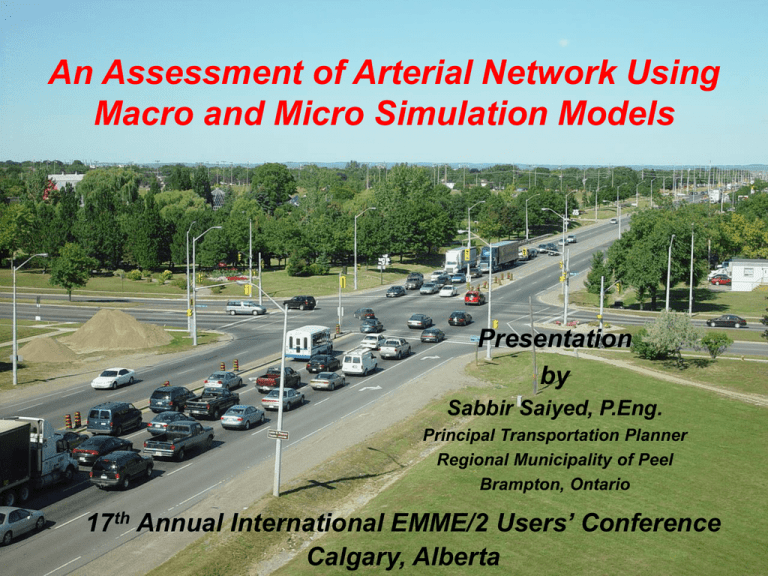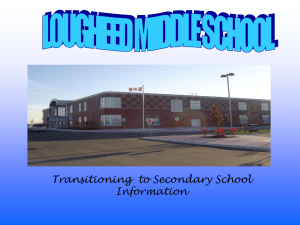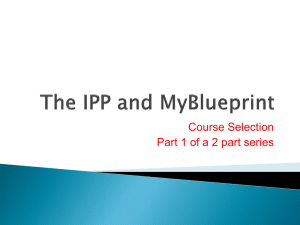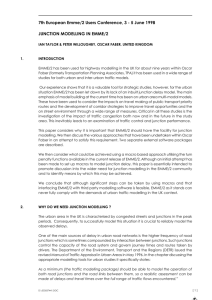4.2_S_Saiyed_Assestment_Arterial_Network
advertisement

An Assessment of Arterial Network Using Macro and Micro Simulation Models Presentation by Sabbir Saiyed, P.Eng. Principal Transportation Planner Regional Municipality of Peel Brampton, Ontario 17th Annual International EMME/2 Users’ Conference Calgary, Alberta Overview Introduction Macro and micro-simulation models Background Region of Peel Region of Peel Travel Demand Forecasting Model Transportation Tomorrow Survey Traffic simulation packages EMME/2 INTEGRATION Synchro & Sim-Traffic Experimental design and methodology Experimental results and discussions Conclusions and recommendations Introduction Transportation systems provide vital service to our community by moving people and goods Operation of transportation systems is an important concern for elected officials and engineers Many cities are experiencing tremendous growth in traffic Several municipalities do not have sufficient funds to meet growing travel demands The emphasis is to improve performance of traffic systems One of the solutions is to improve performance of traffic systems by integrating planning and operational analysis This presentation describes the process of integrating Regional travel demand model with micro-simulation models such as INTEGRATION, Synchro and Sim-Traffic Macro Simulation Models Macro simulation models such as Regional Travel Demand (RTM) models are used by most municipalities to forecast current and future travel demands These models are used for transportation and land use planning Generally, they involve 4-step approach involving trip generation, trip distribution, modal choice and trip assignment Micro-simulation models Micro-simulation models– an important tool in transportation planning Micro Simulation Models e.g. INTEGRATION, Synchro, SimTraffic, VISSIM, PARAMICS, etc. Micro simulation models simulate car following and lane change behavior of drivers on a second by second basis Displays output in the form of animation that shows individual cars, buses, trucks, etc. These models work at an incredibly detailed level and requires equally detailed data Provides data on speeds, delays and emissions Macro and Micro Simulation Models at other Municipalities Several municipalities are employing macro and micro simulation models City of Calgary is currently supplementing Regional Transportation Demand (RTM) model by using micro-simulation models developed using Vissim City of Edmonton is also employing microsimulation models to analyze and design LRT expansion project City of Toronto is using PARAMICS to evaluate and test ITS initiatives Region of Peel is using micro-simulation models for analyzing arterials and freeways in addition to RTM Region of Peel is strategically located… Region of Peel Region of Peel is 2nd largest municipality in Ontario, 5th largest in Canada and it is growing rapidly Serves over 1 million residents It covers City of Mississauga, City of Brampton and Town of Caledon Provides services such as health, regional planning, housing, transportation, water, sewers, and other municipal services Images of Peel Rapid population growth and commercial development have transformed what was primarily a rural area of farms and villages into a dynamic blend of urban, industrial and residential areas. Region of Peel Model - Background Regional staff developed the Peel Region’s first travel demand model in 1978 Model was being run on mainframe computer using modeling software developed by MTO and United States DOT (UTPS package) Acquired emme/2 software in 1989 and Regional staff developed the simplified version of model Model was calibrated/validated using 1986 TTS and Cordon Count data Since then model is updated on continuous basis Region of Peel Model Four staged model consisting of Trip generation Trip distribution Modal split Trip assignment Model simulates a.m. peak hour trips Model uses land use and transportation data from Transportation Tomorrow Survey (TTS) and Census It is validated using Cordon Count data and counts obtained from traffic and transit departments Several scenarios has been developed for existing and horizon years such as 1996, 2001, 2011, 2021 and 2031 Structure of Region of Peel model Trip Generation Trip Distribution External Trips Airport Trips Apply Growth Factors Apply Growth Factors Modal Split Auto Occupancy Trip Assignment Peel Traffic Zone System Traffic zone system used by Peel’s Model is based on Greater Toronto Area (GTA) zone system There are over 500 traffic zones in Peel and GTA Level of details vary over GTA Zone system is fairly detailed within Peel, with diminishing level of details away from boundary City of Toronto contains large number of zones due to its size and trips to and from downtown Oakville has been coded in fine detail Mode split model has been aggregated in 27 zone groups and occupancy model in 47 zone groups York Peel Toronto Halton Durham Transportation Tomorrow Survey Transportation Tomorrow Survey is an important O-D Survey conducted by Regional Municipality of Peel, the Province of Ontario, 15 other municipalities in Southern Ontario, GO Transit and Toronto Transit Commission The most recent survey was completed in 2001, with the previous ones carried out in 1986, 1991 and 1996 The trip data contains information about the household and trips made by each person in the household including trip origin, trip destination, trip purpose, start time and mode of travel This data is geo-coded and data is available for input into Emme/2 and other models The O-D matrix developed for the analysis in this paper is based on the data collected from TTS survey and is used as input both for Emme/2 and INTEGRATION software Traffic simulation packages Traffic simulation packages used in this study are: Emme/2 Synchro and Sim-Traffic INTEGRATION The transportation network was created using Emme/2 transportation planning software Synchro and Sim-Traffic were used to model pretimed and actuated signal control INTEGRATION was used to simulate adaptive signal controls Emme/2 Software Emme/2 is an interactive multi-modal transportation planning software used worldwide for over 20 years It offers a complete and comprehensive set of tools for demand modeling, multi-modal network modeling and analysis for implementing evaluation procedures for transportation planning Its data bank is structured to permit simultaneous descriptions, analysis and comparison of several transportation planning scenarios In this study, emme/2 is used to develop and code transportation network and to generate O-D matrix for input in INTEGRATION model Synchro Synchro is a complete software package for modeling and optimizing traffic signal timings It optimises cycle lengths, splits, offsets and phase orders Synchro also optimises multiple cycle lengths and performs coordination analysis Synchro can analyse pre-timed and actuated signal control systems It can optimise the entire network or group of arterials and intersections in a single run Synchro has colourful, informative time-space diagrams It provides more than 17 reports on several measures of effectiveness of signalized intersection Sim-Traffic Sim-Traffic is companion traffic model that comes with Synchro and it is a microscopic simulation model It is designed to model networks of signalized and unsignalized intersections It can be used to check and fine tune traffic signal operations and is useful for analyzing complex situations such as closely spaced intersections and intersections under heavy congestion It can model pre-timed and actuated signal controls Each vehicle in the traffic network is individually tracked through the model and comprehensive measures of effectiveness are recorded during simulation INTEGRATION Model Developed in late 1980s by late Dr. M. Van Aerde with extensive support of MTO INTEGRATION model is an attempt to provide a single model that could consider both freeways and arterials as well as traffic assignment and simulation This ability is intended to bridge a gap between the planning models as well as traffic operational models/tools INTEGRATION model can also model Intelligent Transportation Systems such as ATMS and ATIS. It can also be used for evaluating TDM (HOV) policies, goods movement (truck sub network), toll roads, intersection improvements, etc. INTEGRATION Model It models the interactions of individual vehicles with freeways, arterials, traffic signals and ITS, while preserving macroscopic properties of each link in the network The model uses Dynamic Traffic Assignment (DTA) in addition to Static Traffic Assignment DTA allows vehicles to reroute according to current traffic conditions of the network INTEGRATION does not require the user to collect input data at the individual vehicle level It uses O-D traffic demands and therefore EMME/2 data can be used effectively The model uses internal logic to determine microscopic measures such as free speeds and densities Experimental Design Transportation network was created in emme/2 software based on real network of Region of Peel with minor modifications to number of lanes and capacities The zone centroids represents the traffic zones of Peel Region A traversal matrix was developed for the study area based on actual O-D survey data There are 26 nodes, 58 links and 77 O-D demand loadings The saturation flow rate was set to regional standards, which is 1900 vehicles/hour, consistent with typical high grade urban network The inter-green time was set to 4 seconds of Amber and 2 seconds for all Red Experimental Methodology The arterial network and a traversal matrix was developed using Emme/2 This network was batched out from Emme/2 and was entered in INTEGRATION software Additionally, the data could be imported into Excel spreadsheet for further changes All the essential files were created for the INTEGRATION model and it was run to simulate traffic demands The turning movement generated using INTGRATION were entered into Synchro to simulate pre-timed and actuated traffic demands Arterial Network Types of Signal Control Traffic engineers can maximise performance of traffic signal by varying cycle time, green splits, offsets and phase types as well as sequencing There are three types of signal control Pre-timed Actuated Adaptive In pre-timed signal controls , there are fixed time plans and time of day plans In actuated signal controls, controller operates on traffic demands based on actuation of vehicles and pedestrians In adaptive signal controls, no preset plans are developed; new signal timing plans are computed dynamically based on prevailing traffic demands Network Totals before Optimisation Pre-timed Actuated Adaptive Total Signal Delay (hr) 90 42 42 Stops/Veh 0.79 0.3 0.45 Total Stops 13049 5045 7698 Average Speed (km/hr) 47 52 50 Total Travel Time (hr) 450 403 425 Distance Travelled (km) 21050 21050 21050 Fuel Consumed (litre) 2509 2123 2019 CO Emissions (kg) 46.66 39.48 66.55 NOx Emissions (kg) 9.01 7.62 3.72 Network Totals – Cycle/Offsets Optimisation Pre-timed Actuated Adaptive Total Signal Delay (hr) 32 27 24 Stops/Veh 0.46 0.45 0.26 Total Stops 7678 7545 4612 Average Speed (km/hr) 54 54 54 Total Travel Time (hr) 392 387 416 Distance Travelled (km) 21050 21050 21050 Fuel Consumed (litre) 2171 2156 1900 CO Emissions (kg) 40.38 40.11 56.26 NOx Emissions (kg) 7.79 7.74 3.22 Total Signal Delays Total Signal Delay (hr) Total Signal Delay 100 80 Before Optimisation 60 After Cycle Optimisation 40 After Offset Optimisation 20 After Cycle/Offset Optimisation 0 Pre-timed Actuated Adaptive Signal Control Types Conclusions and Recommendations Emme/2 could be effectively utilized to develop a regional travel demand model Transportation network could be easily developed using Emme/2 for input into micro-simulation model Emme/2 could be used to develop sub-area model and also for developing traversal matrix Emme/2 could be easily integrated with microsimulation models such as INTEGRATION, Synchro and Sim-Traffic to provide additional measures of effectiveness for arterial network for transportation planning and operational analysis Conclusions and Recommendations INTEGRATION offers Dynamic Traffic Assignment method in addition to traditional methods of assignment Sim-Traffic and the INTEGRATION models produce an on-line simulation display that can be efficiently used to visualize traffic flow and to analyze the measures of effectiveness of the network Sim-Traffic could be used to simulate and animate to determine operational level traffic problems Synchro could be effectively used to determine macro level LOS and delays Conclusions and Recommendations The experiment also demonstrates that Synchro, SimTraffic and INTEGRATION could be used to analyze pretimed, actuated and adaptive traffic signal controls It is shown that optimization improves the performance of the arterial network It is recommended that further work should be carried out to examine medium and large network using above methodology The results of the experiment would provide additional information and a better understanding of several measures of effectiveness for effective transportation planning and operation analysis Thank you






